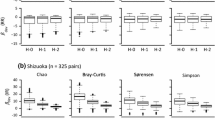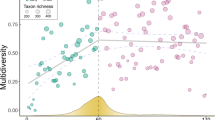Abstract
Various ecological processes influence patterns of species diversity at multiple spatial scales. One process that is potentially important but rarely considered is community assembly. I assembled model communities using species pools of differing size to examine how the history of community assembly may affect multi-scale diversity patterns. The model contained three scales at which diversity could be measured: local community, metacommunity, and species pool. Local species saturation occurred, as expected from the competition and predation built in the model. However, local communities did not become resistant to invasions except when the species pool was very small. Depending on dispersal rate and trophic level, the larger the species pool, the harder it was to predict which species invades which local community at a given time. Consequently, local-community dissimilarity maintained by assembly history increased linearly with pool size, even though local diversity was decoupled from pool size. These results have two implications for multi-scale diversity patterns. First, assembly history may provide an explanation for scale-dependent relationships between local and regional diversity: assembly causes the relationship to be curvilinear at one scale (local community), while linear at another (metacommunity). Second, assembly history influences how γ-diversity is partitioned into α- and β-diversity: assembly causes the relative contribution of β to increase with pool size. Overall, this study suggests that community assembly history interacts with species pool size to regulate multi-scale patterns of species diversity.






Similar content being viewed by others
References
Abrams PA (2001) Describing and quantifying interspecific interactions: a commentary on recent approaches. Oikos 94:209–218
Berlow EL, Navarrete SA, Briggs CJ, Power ME, Menge BA (1999) Quantifying variation in the strengths of species interactions. Ecology 80:2206–2224
Bini LM, Diniz Filho JAF, Bonfim F, Bastos RP (2000) Local and regional species richness relationships in viperid snake assemblages from South America: unsaturated patterns at three different spatial scales. Copeia 2000:799–805
Blueweiss L, Fox H, Kudzma V, Nakashima D, Peters R, Sams S (1978) Relationships between body size and some life history parameters. Oecologia 37:257–272
Caley MJ, Schluter D (1997) The relationship between local and regional diversity. Ecology 78:70–80
Case TJ (1990) Invasion resistance arises in strongly interacting species-rich model competition communities. Proc Natl Acad Sci USA 87:9610–9614
Chase JM (2003) Community assembly: when should history matter? Oecologia 136:489–498
Cohen JE, Pimm SL, Yodzis P, Saldana J (1993) Body sizes of animal predators and animal prey in food webs. J Anim Ecol 62:67–78
Connell JH, Sousa WP (1983) On the evidence needed to judge ecological stability or persistence. Am Nat 121:789–824
Connor EF, Simberloff D (1979) The assembly of species communities: chance or competition? Ecology 60:1132–1140
Cornell HV, Karlson RH (1997) Local and regional processes as controls of species richness. In: Tilman D, Kareiva P (eds) Spatial ecology: the role of space in population dynamics and interspecific interactions. Princeton University Press, Princeton, pp 250–268
Cornell HV, Lawton JH (1992) Species interactions, local, and regional processes, and limits to the richness of ecological communities: a theoretical perspective. J Anim Ecol 61:1–12
Crist TO, Veech JA, Gering JC, Summerville KS (2003) Partitioning species diversity across landscapes and regions: a hierarchical analysis of α, β, and γ diversity. Am Nat 162:734–743
Drake JA (1990) The mechanics of community assembly and succession. J Theor Biol 147:213–233
Fager EW (1968) The community of invertebrates in decaying oak wood. J Anim Ecol 37:121–142
Fenchel T (1974) Intrinsic rate of natural increase: the relationship with body size. Oecologia 14:317–326
Fox JW, McGrady-Steed J, Petchey OL (2000) Testing for local species saturation with nonindependent regional species pools. Ecol Lett 3:198–206
Fourier E, Loreau M (2001) Respective roles of recent hedges and forest patch remnants in the maintenance of ground-beetle (Coleoptera: Carabidae) diversity in an agricultural landscape. Landscape Ecol 16:17–32
Fukami T, Morin PJ (2003) Productivity–biodiversity relationships depend on the history of community assembly. Nature 424:423–426
Gering JC, Crist TO (2002) The alpha–beta-regional relationship: providing new insights into local–regional patterns of species richness and scale dependence of diversity components. Ecol Lett 5:433–444
Gilpin ME, Diamond JM (1984) Are species co-occurrences on islands non-random, and are null hypotheses useful in community ecology? In: Strong DR, Simberloff D, Abele LG, Thisle AB (eds) Ecological communities: conceptual issues and the evidence. Princeton University Press, Princeton, pp 297–315
Godfray HCJ, Lawton JH (2001) Scale and species numbers. Trends Ecol Evol 16:400–404
Grover JP, Lawton JH (1994) Experimental studies on community convergence and alternative states: comments on a paper by Drake et al. J Anim Ecol 63:484–487
Hall G, Watt JM (eds) (1976) Modern methods for ordinary differential equations. Clarendon, Oxford
Harvey E, Miller TE (1996) Variance in composition in inquiline communities in leaves of Sarracenia purpurea L. on multiple spatial scales. Oecologia 108:562–566
Hillebrand H, Blenckner T (2002) Regional and local impact on species diversity—from pattern to processes. Oecologia 132:479–491
Humphreys WF (1979) Production and respiration in animal populations. J Anim Ecol 48:427–453
Huston MA (1999) Local processes and regional patterns: appropriate scales for understanding variation in the diversity of plants and animals. Oikos 86:393–401
Karlson RH, Cornell HV (1998) Scale-dependent variation in local versus regional effects on coral species richness. Ecol Monogr 68:259–274
Law R (1999) Theoretical aspects of community assembly. In: McGlade J (ed) Advanced ecological theory: principles and applications. Blackwell, Oxford, pp 143–171
Law R, Morton RD (1993) Alternative permanent states of ecological communities. Ecology 74:1347–1361
Law R, Morton RD (1996) Permanence and the assembly of ecological communities. Ecology 77:762–775
Lawton JH (1999) Are there general laws in ecology? Oikos 84:177–192
Lewontin RC (1969) The meanings of stability. Brookhaven Symp Biol 22:13–24
Lockwood JL, Powell RD, Nott MP, Pimm SL (1997) Assembling ecological communities in time and space. Oikos 80:549–553
Loreau M (2000) Are communities saturated? On the relationship between α, β, and γ diversity. Ecol Lett 3:73–76
Lundberg P, Ranta E, Kaitala V (2000) Species loss leads to community closure. Ecol Lett 3:465–468
MacArthur RH (1972) Geographical ecology. Harper and Row, New York
McCann KS (2000) The diversity–stability debate. Nature 405:228–233
Morton RD, Law R (1997) Regional species pools and the assembly of local ecological communities. J Theor Biol 187:321–331
Morton RD, Law R, Pimm SL, Drake JA (1996) On models for assembling ecological communities. Oikos 75:493–499
Mouquet N, Loreau M (2003) Community patterns in source-sink metacommunities. Am Nat 162:544–557
Mouquet N, Munguia P, Kneitel JM, Miller TE (2003) Community assembly time and the relationship between local and regional species richness. Oikos 103:618–626
Noda T (2004) Spatial hierarchical approach in community ecology: a way beyond low predictability of local phenomena. Popul Ecol (this issue)
Numerical Algorithms Group (2002) NAG C Library, Mark 7. Numerical Algorithms Group, Oxford
Paine RT (1992) Food-web analysis through field measurement of per capita interaction strength. Nature 355:73–75
Petersen CH (1984) Does a rigorous criterion for environmental identity preclude the existence of multiple stable points? Am Nat 124:127–133
Post WM, Pimm SL (1983) Community assembly and food web stability. Math Biosci 64:169–192
Remmert H (1991) The mosaic-cycle concept of ecosystems. Springer, Berlin Heidelberg New York
Ricklefs RE (1987) Community diversity: relative roles of local and regional processes. Science 235:167–171
Ricklefs RE (2000) The relationship between local and regional species richness in birds of the Caribbean Basin. J Anim Ecol 69:1111–1116
Ricklefs RE, Schluter D (eds) (1993) Species diversity in ecological communities: historical and geographical perspectives. University of Chicago Press, Chicago
Rosenzweig ML, Ziv Y (1999) The echo pattern of species diversity: pattern and processes. Ecography 22:614–628
Sala E, Graham MH (2002) Community-wide distribution of predator–prey interaction strength in kelp forests. Proc Natl Acad Sci USA 99:3678–3683
Samuels CL, Drake JA (1997) Divergent perspectives on community convergence. Trends Ecol Evol 12:427–432
Selmi S, Boulinier T (2001) Ecological biogeography of Southern Ocean islands: the importance of considering spatial issues. Am Nat 158:426–437
Shurin JB, Allen EG (2001) Effects of competition, predation, and dispersal on species richness at local and regional scales. Am Nat 158:624–637
Shurin J, Srivastava DS (2004) New perspectives on local and regional diversity: beyond saturation. In: Holyoak M, Leibold M, Holt R (eds) Metacommunities. University of Chicago Press, Chicago (in press)
Shurin JB, Havel JE, Leibold MA, Pinel-Alloul B (2000) Local and regional zooplankton species richness: a scale-independent test for saturation. Ecology 81:3062–3073
SPSS (2000) SYSTAT. Version 10. SPSS, Chicago
Srivastava DS (1999) Using local–regional richness plots to test for species saturation: pitfalls and potentials. J Anim Ecol 68:1–16
Steiner CF, Leibold MA (2004) Cyclic assembly trajectories and scale-dependent productivity–diversity relationships. Ecology 85:107–113
Sutherland JP (1974) Multiple stable points in natural communities. Am Nat 108:859–873
Sutherland JP (1990) Perturbations, resistance, and alternative views of the existence of multiple stable points in nature. Am Nat 136:270–275
Terborgh JW, Faaborg J (1980) Saturation of bird communities in the West-Indies. Am Nat 116:178–195
Veech JA, Summerville KS, Crist TO, Gering JC (2002) The additive partitioning of species diversity: recent revival of an old idea. Oikos 99:3–9
Warren PH, Law R, Weatherby AJ (2003) Mapping the assembly of protist communities in microcosms. Ecology 84:1001–1011
Westoby M (1998) The relationship between local and regional diversity: comment. Ecology 79:1825–1827
Whittaker RH (1972) Evolution and measurement of species diversity. Taxon 21:213–251
Wilmers CC, Sinha S, Brede M (2002) Examining the effects of species richness on community stability: an assembly model approach. Oikos 99:363–367
Wilson DS (1992) Complex interactions in metacommunities, with implications for biodiversity and higher levels of selection. Ecology 73:1984–2000
Acknowledgments
I thank Masahiro Nakaoka and Takashi Noda for inviting me to contribute to this Special Feature. I thank Richard Law and Chris Cosner for technical advice and Marc Cadotte, Jon Chase, Jim Drake, Sean McMahon, Mac Post, Susan Riechert, Jon Shurin, Dan Simberloff, Diane Srivastava, Chris Steiner, Diego Vázquez, and two insightful anonymous reviewers for comments. Aaron King deserves special thanks for numerous discussions that improved this paper. This research was funded by the US National Science Foundation (DEB-0206598) and the Yates Dissertation Fellowship at the University of Tennessee, Knoxville.
Author information
Authors and Affiliations
Corresponding author
Rights and permissions
About this article
Cite this article
Fukami, T. Community assembly along a species pool gradient: implications for multiple-scale patterns of species diversity. Popul Ecol 46, 137–147 (2004). https://doi.org/10.1007/s10144-004-0182-z
Received:
Accepted:
Published:
Issue Date:
DOI: https://doi.org/10.1007/s10144-004-0182-z




